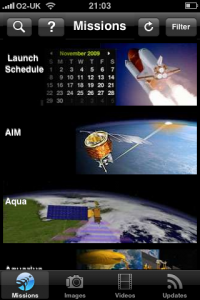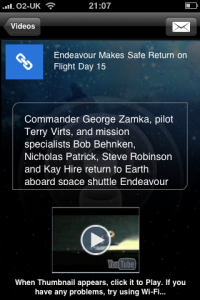The New York Times has never printed a larger headline than when Neil Armstrong took the first steps on the moon in 1969. Apollo 11, NASA’s most successful creation, breached the gap between Earth and space some forty years ago; an incredible feat in the space race that has changed - quite literally - how we view the world today.
Finding information on space and NASA used to require a trip to the library, dusting off an encyclopedia and spending hours searching for a few pieces of information. Some would call those the good old days. But now we have wikipedia, the NASA website and now the official NASA iPhone application. We’ve got the whole world in our hands. And then some. So let’s see how it delivers.
I’m no astrophysicist, but the layout of the application makes generous use of the iPhone’s display and navigation is easy. We all have different ideas about what makes a “good” application “great” - for me it’s the layout and design. How easy it is to use. The NASA app is surprisingly easy for what is the most complex subject in the world.
By far one of the most impressive features that I’ve seen so far is the ability to see when a nearby object passes by Earth. Click on an object, load a map, and it’ll get your current location and the location of the object (eg. International Space Station) - if it’s over you, you may be able to spot it!
There are four categories - Missions, Images, Videos and Updates. Options to filter, refresh and search, as well as a handy help guide, are accessible from almost every page.
Missions The “command central” of the NASA application. A complete launch schedule, as well as a list of shuttles, satellites and space bases can all be found here. Acronyms were unavoidable (we are talking about space), but every section here has more information when you tap on it. From the International Space Station to the Solar Terrestrial Relations Observatory (STEREO), technical information, an overview and a sort of “mission statement” is right at hand for your viewing. Quick facts make for interesting reading too.
The “command central” of the NASA application. A complete launch schedule, as well as a list of shuttles, satellites and space bases can all be found here. Acronyms were unavoidable (we are talking about space), but every section here has more information when you tap on it. From the International Space Station to the Solar Terrestrial Relations Observatory (STEREO), technical information, an overview and a sort of “mission statement” is right at hand for your viewing. Quick facts make for interesting reading too.
Within each section there is a plethora of images and videos, as well a “count-up” timer that tells you how long the object you’re looking at has been active for. The language is understandable, and you’ll understand what you’re reading about. You can filter what feeds you want to see, composed of: Earth; Moon and Mars; Solar System; Universe; and Highlighted Missions.
Images
Two sections totaling almost 7000 images to date ensure that you always have something new to see. IOTD (image of the day) and APOD (astronomy picture of the day) show fascinating pictures of earth, space objects, planets and more. We even found one of President Barack Obama in there somewhere. The images load 16 tiles at a time, so data usage is kept low. Information on each photo is also present, as well as the option to view the photos as a slideshow and even save them to your camera roll or e-mail them.
Videos
There are thirteen video feeds to choose from, each with their own directory. Noteworthy are NASA eClips - short, relevant educational video segments - and NASA Television. There’s no live TV yet, but we did get in touch with a NASA official who told us that “we developed that capability ... but we were forced to hold back on reliable delivery.” Current videos are all YouTube embedded.
Updates
As you can imagine, this section offers updates on what’s happening in the world of NASA. These feeds can be filtered, with an array of options to choose from. The presentation is clean, and whenever you tap on an update there is a space-theme about it, with an option to mail it to anyone. There are no push notifications, but updates are frequent (usually around ten-twelve per day) - so there’s always something new to read.
Whilst we aren’t keen to criticize what is a beautifully designed application, it could benefit from increased iPhone integration. For example, under the feeds of different categories I feel it would be better suited to have the Apple style select (think Weather, Clock and Stocks). It’s up to you whether no landscape mode is an advantage or disadvantage. There are some minor graphical design faults evident in the screenshots below, but don’t let this detract from what is otherwise a well functioning application. The addition of live NASA TV is what will make this app go from “great” to “brilliant” - but it is nonetheless an attractive application that has both form and function, particularly through little additions such as preventing sleep mode and downloading higher quality images. Summarizing space on the iPhone screen is no easy feat.
We look forward to the next launch.
[gallery type="thumbnail"]
PocketGamer.com
AppSpy.com
148Apps.com
PocketGamer.fr
PocketGamer.biz
PCGamesInsider.biz
The Sims News
PocketGamer.fun
BlockchainGamer.biz
PG Connects
BigIndiePitch.com
MobileGamesAwards.com
 U.GG
U.GG
 Icy Veins
Icy Veins
The Sims Resource
Fantasy Football Scout
GameKnot
Addicting Games
 Arcade Cloud
Arcade Cloud
 Wisecrack
Wisecrack
 EV.IO
EV.IO
Luminosity

 The “command central” of the NASA application. A complete launch schedule, as well as a list of shuttles, satellites and space bases can all be found here. Acronyms were unavoidable (we are talking about space), but every section here has more information when you tap on it. From the International Space Station to the Solar Terrestrial Relations Observatory (STEREO), technical information, an overview and a sort of “mission statement” is right at hand for your viewing. Quick facts make for interesting reading too.
The “command central” of the NASA application. A complete launch schedule, as well as a list of shuttles, satellites and space bases can all be found here. Acronyms were unavoidable (we are talking about space), but every section here has more information when you tap on it. From the International Space Station to the Solar Terrestrial Relations Observatory (STEREO), technical information, an overview and a sort of “mission statement” is right at hand for your viewing. Quick facts make for interesting reading too.